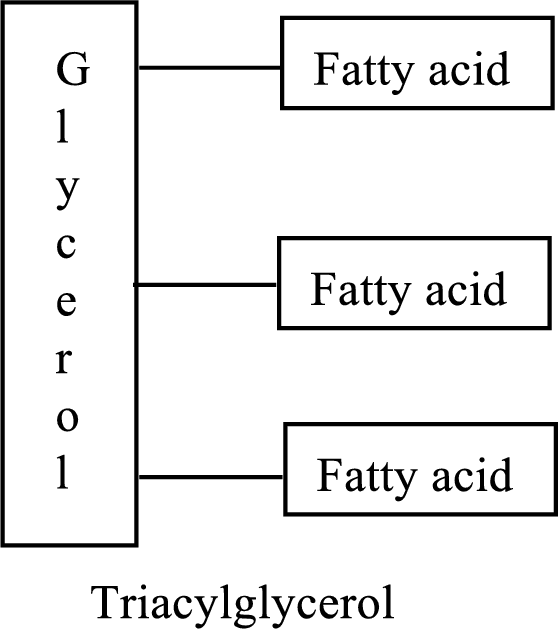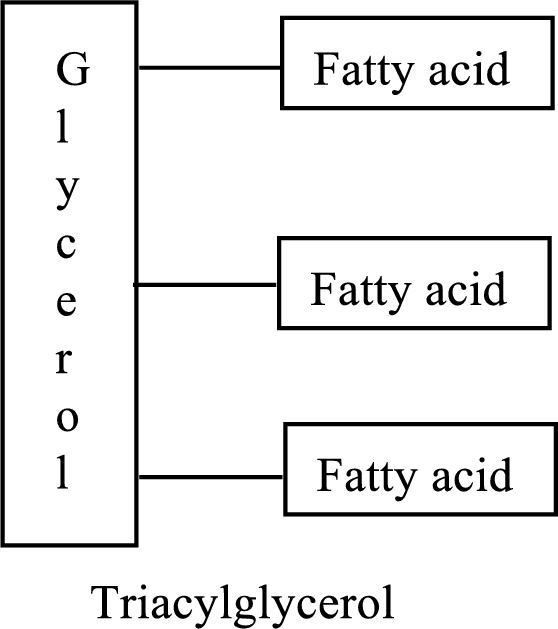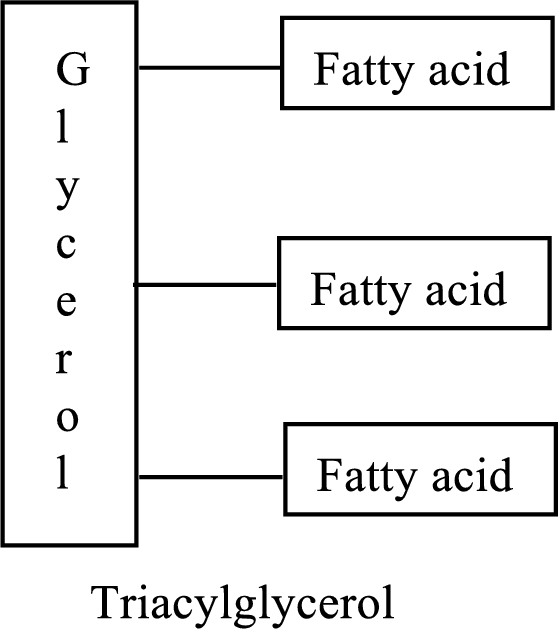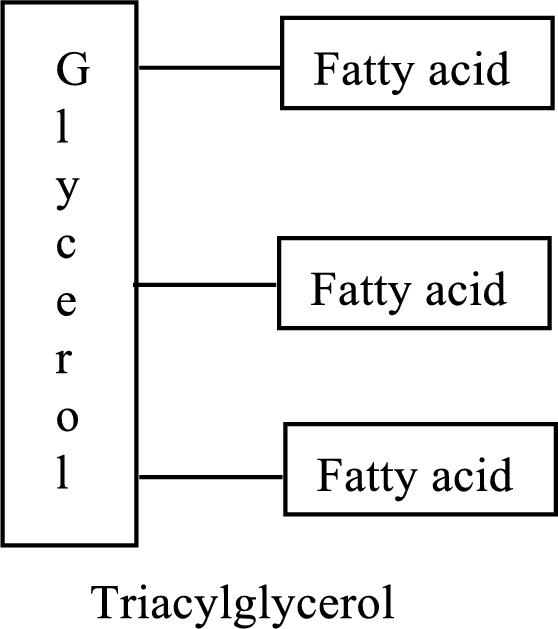
Concept explainers
(a)
Interpretation:
Whether the statement “about 50% of TAGs undergo complete hydrolysis in the stomach” concerning to triacylglycerol(TAG) digestion is true or false has to be determined.
Concept introduction:
Triacylglycerols are lipid molecules which constitute around 98% of the total dietary lipids. These lipid molecules undergo digestion/breakdown into simpler forms in the

(b)
Interpretation:
Whether the statement “cholecystokinin is the chemical name for bile” concerning to triacylglycerol(TAG) digestion is true or false has to be determined.
Concept introduction:
Triacylglycerols are lipid molecules which constitute around 98% of the total dietary lipids. These lipid molecules undergo digestion/breakdown into simpler forms in the digestive system and are later absorbed into the bloodstream. In the bloodstream, the hydrolysis products of triacylglycerols (fatty acids and glycerol) are absorbed by the body cells and are either broken down into acetyl CoA or stored as lipids for future use. Fats/Lipids are a richer source of energy compared to carbohydrates. While carbohydrates provide energy for immediate use, lipids provide energy for long term or future use. The structure of triacylglycerols is as follows:

(c)
Interpretation:
Whether the statement “most TAGs usually enter the small intestine in the form of monoacylglycerols” concerning to triacylglycerol(TAG) digestion is true or false has to be determined.
Concept introduction:
Triacylglycerols are lipid molecules which constitute around 98% of the total dietary lipids. These lipid molecules undergo digestion/breakdown into simpler forms in the digestive system and are later absorbed into the bloodstream. In the bloodstream, the hydrolysis products of triacylglycerols (fatty acids and glycerol) are absorbed by the body cells and are either broken down into acetyl CoA or stored as lipids for future use. Fats/Lipids are a richer source of energy compared to carbohydrates. While carbohydrates provide energy for immediate use, lipids provide energy for long term or future use. The structure of triacylglycerols is as follows:

(d)
Interpretation:
Whether the statement “chyme produced in the stomach settles to the bottom of the stomach” concerning to triacylglycerol(TAG) digestion is true or false has to be determined.
Concept introduction:
Triacylglycerols are lipid molecules which constitute around 98% of the total dietary lipids. These lipid molecules undergo digestion/breakdown into simpler forms in the digestive system and are later absorbed into the bloodstream. In the bloodstream, the hydrolysis products of triacylglycerols (fatty acids and glycerol) are absorbed by the body cells and are either broken down into acetyl CoA or stored as lipids for future use. Fats/Lipids are a richer source of energy compared to carbohydrates. While carbohydrates provide energy for immediate use, lipids provide energy for long term or future use.
The structure of triacylglycerols is as follows:

Want to see the full answer?
Check out a sample textbook solution
Chapter 14 Solutions
EBK ORGANIC AND BIOLOGICAL CHEMISTRY
- Draw the Fischer projection from the skeletal structure shown below. HO OH OH OH OH H Q Drawing Atoms, Bonds and Rings Charges I ☐ T HO H H OH HO I CH2OH H OH Drag H OH -CH2OH CHO -COOH Undo Reset Remove Donearrow_forwardplease provide the structure for this problem, thank youarrow_forwardpresented by Morallen Lig Intermine the hand product for the given mution by adding atoms, bonds, nonhonding diarion panda скуль Step 3: Comp the draw the product Step 2: Agama workup Compithe 429 ملولةarrow_forward
- Reaction A 0,0arrow_forwardpresented by Morillon Leaning Predict the organic product for the min кусур HSC Adithane carved arnown to come than that to the condon slchroruis in acid in in aquishri with ноюarrow_forward6.15PM Sun Mar 30 K Draw the major product of this reaction. Include any relevant stereochemistry. Ignore inorganic byproducts. Problem 1 of O H [PhзPCH2CH3]*C|¯ NaH Drawing > Q Atoms, Bonds and Draw or tap a nearrow_forward
- 8:17 PM Sun Mar 30 Draw the major product of this reaction. Ignore inorganic byproducts. HSCH2CH2CH2SH, BF3 Probler Drawing Ato Bonds Clarrow_forwardpresented by Mr L How the coprion. (Il Done in no wraction, dew the starting redential) доarrow_forward8:16 PM Sun Mar 30 K Draw the major product of this reaction. Ignore inorganic byproducts. Proble 1. CH3MgBr 2. H3O+ F Drawingarrow_forward
- о но оarrow_forwardName the major organic product of the following action of 4-chloro-4-methyl-1-pentanol in neutral pollution 10+ Now the product. The product has a molecular formula f b. In a singly hain, the starting, material again converts into a secule with the molecular kormula CIO. but with comply Draw the major organic structure inhalationarrow_forwardMacmillan Learning Alcohols can be oxidized by chromic acid derivatives. One such reagent is pyridinium chlorochromate, (C,H,NH*)(CICTO3), commonly known as PCC. Draw the proposed (neutral) intermediate and the organic product in the oxidation of 1-butanol by PCC when carried out in an anhydrous solvent such as CH₂C₁₂. PCC Intermediate OH CH2Cl2 Draw the intermediate. Select Draw Templates More с H Cr о Product Draw the product. Erase Select Draw Templates More H о Erasearrow_forward
 General, Organic, and Biological ChemistryChemistryISBN:9781285853918Author:H. Stephen StokerPublisher:Cengage Learning
General, Organic, and Biological ChemistryChemistryISBN:9781285853918Author:H. Stephen StokerPublisher:Cengage Learning Organic And Biological ChemistryChemistryISBN:9781305081079Author:STOKER, H. Stephen (howard Stephen)Publisher:Cengage Learning,
Organic And Biological ChemistryChemistryISBN:9781305081079Author:STOKER, H. Stephen (howard Stephen)Publisher:Cengage Learning, Chemistry for Today: General, Organic, and Bioche...ChemistryISBN:9781305960060Author:Spencer L. Seager, Michael R. Slabaugh, Maren S. HansenPublisher:Cengage Learning
Chemistry for Today: General, Organic, and Bioche...ChemistryISBN:9781305960060Author:Spencer L. Seager, Michael R. Slabaugh, Maren S. HansenPublisher:Cengage Learning Introduction to General, Organic and BiochemistryChemistryISBN:9781285869759Author:Frederick A. Bettelheim, William H. Brown, Mary K. Campbell, Shawn O. Farrell, Omar TorresPublisher:Cengage Learning
Introduction to General, Organic and BiochemistryChemistryISBN:9781285869759Author:Frederick A. Bettelheim, William H. Brown, Mary K. Campbell, Shawn O. Farrell, Omar TorresPublisher:Cengage Learning Chemistry In FocusChemistryISBN:9781305084476Author:Tro, Nivaldo J., Neu, Don.Publisher:Cengage Learning
Chemistry In FocusChemistryISBN:9781305084476Author:Tro, Nivaldo J., Neu, Don.Publisher:Cengage Learning




